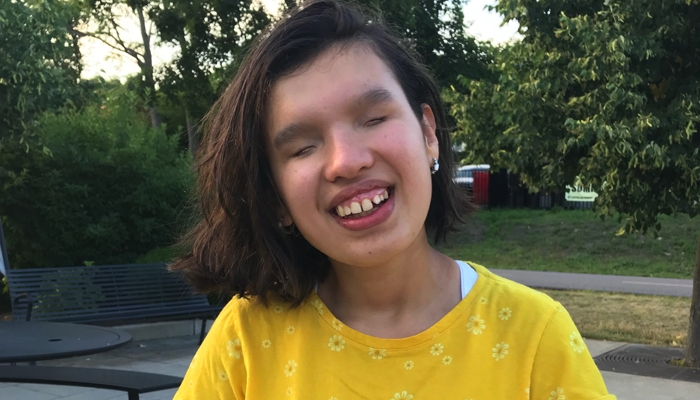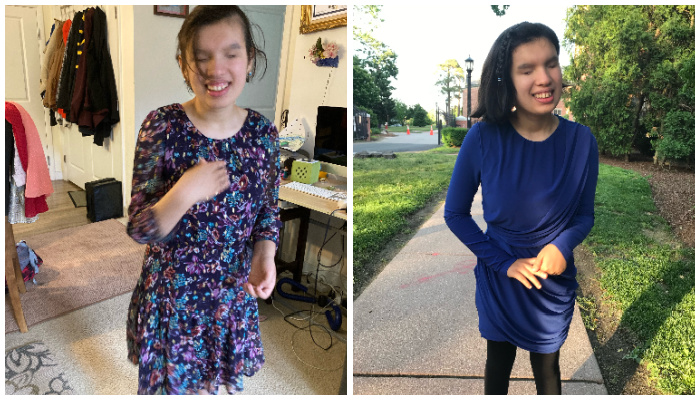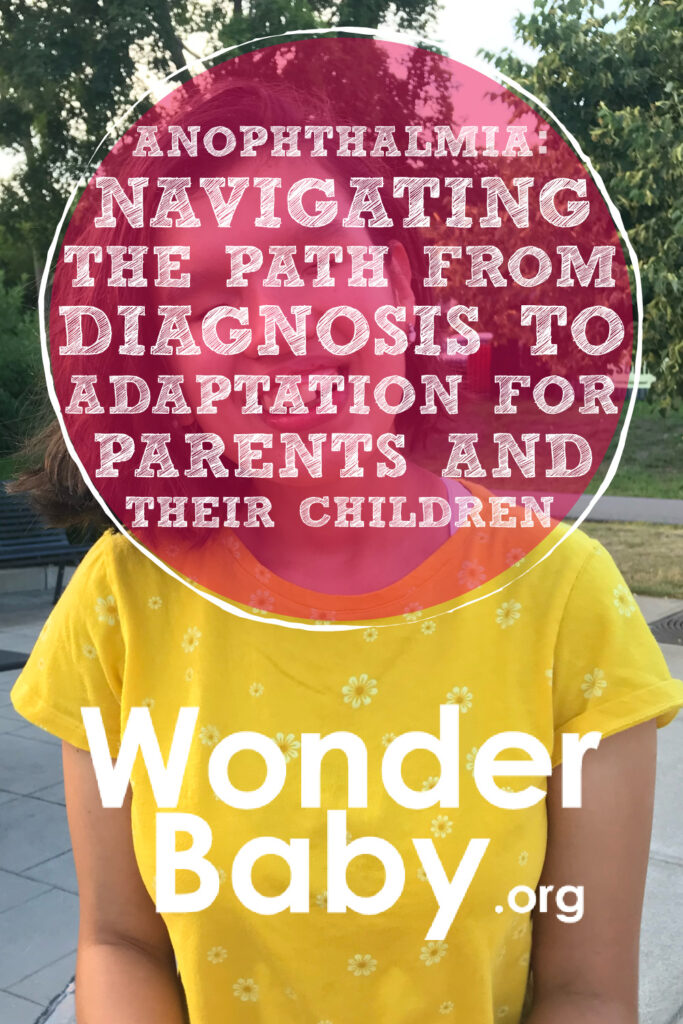Anophthalmia: Navigating the Path from Diagnosis to Adaptation for Parents and Their Children

- Anophthalmia is a rare birth defect that may signal the presence of other congenital conditions.
- There is more than one type of anophthalmia.
- Early intervention and the use of visual modifications can help your visually impaired baby successfully adapt to life with this condition.
What is anophthalmia? Unless you have a family history of this condition, you may never have heard of it before.
Anophthalmia is a birth defect where one or both eyes fail to form. A related condition, microphthalmia, happens when one or both eyes develop and are abnormally small. Both conditions are marked by vision problems, vision loss, and blindness.
As a parent of a visually impaired child, you may wonder what life will be like for your little one and whether there are strategies or adaptations available to help them navigate the challenges that are part of life with blindness.
Understanding the Diagnosis

The body processes behind anophthalmia and microphthalmia can be difficult to understand.
It may help to know that a baby’s eyes are beginning to form very early in pregnancy—right around the time most mothers learn they’re expecting.
Experts at the Charlotte Lozier Institute11. Eye Formation. Lozier Institute. 2023. https://lozierinstitute.org/dive-deeper/eye-formation/#:~:text=The%20eyes%20begin%20forming%2022,the%20eye%20to%20the%20brain. inform us that as early as 22 days after conception, “tissue from the developing brain pushes forward towards the face to form an optic cup and the beginnings of the optic nerve, which will connect the eye to the brain.”
Because many mothers may not know they’re pregnant, environmental factors and lifestyle choices make this a very delicate time for a growing baby and can affect a little one’s visual development.
Causes
While anophthalmia and microphthalmia are relatively rare eye conditions, both share similar causes.
For instance, both conditions are considered congenital disorders, meaning that these birth defects occurred while the eyes were forming22. Ludwig PE, Lopez MJ, Czyz CN. Embryology, Eye Malformations. In: StatPearls [Internet]. Treasure Island (FL): StatPearls Publishing. 2023. https://www.ncbi.nlm.nih.gov/books/NBK482496 before your baby was born.
Researchers exploring the genetics behind the conditions33. Plaisancié, J., Ceroni, F., Holt, R., Zazo Seco, C., Calvas, P., Chassaing, N., & Ragge, N. K.. Genetics of Anophthalmia and microphthalmia. part 1: Non-syndromic Anophthalmia/Microphthalmia. Human Genetics. 2019;138(8–9), 799–830. https://doi.org/10.1007/s00439-019-01977-y have identified 30 individual genes that have regularly occurred in those with a family history of anophthalmia and/or microphthalmia. They have also identified several risk factors that increase a baby’s chance of developing these and other rare eye disorders.
Maternal Risk Factors
Experts at the American Academy of Ophthalmology44. Curley, M., Barmettler, A., Prakalapakorn, S. G., & Osigian, C. J.. Anophthalmia. EyeWiki. 2023. https://eyewiki.aao.org/Anophthalmia#:~:text=Risk%20factors%20for%20anophthalmia%20include,such%20as%20warfarin%20and%20alcohol. report that babies have an increased risk of developing anophthalmia if their mothers have:
- Advanced maternal age (greater than 40)
- Infections while pregnant (like rubella, parvovirus, or toxoplasmosis)
- Untreated vitamin A deficiency
- A high fever for some time while pregnant
- Exposure to toxins like alcohol or certain types of blood thinners
- Treatment55. Mother To Baby | Fact Sheets. Isotretinoin (Accutane®). 2021. https://www.ncbi.nlm.nih.gov/books/NBK582775 with certain medicines used to treat skin conditions or severe acne in adults, even if the treatment is relatively short
Infant Risk Factors
Researchers also reported that babies are more likely to develop anophthalmia if they:
- Were a twin, triplet, etc. (i.e. multiple births)
- Had low birthweight
- Were premature
Like many other genetic disorders, anophthalmia sometimes occurs without a known cause66. Facts about Anophthalmia / Microphthalmia. Centers for Disease Control and Prevention. 2023. https://www.cdc.gov/ncbddd/birthdefects/anophthalmia-microphthalmia.html#:~:text=The%20causes%20of%20anophthalmia%20and,)%20or%20thalidomide%2C%20during%20pregnancy.. In these cases, genetic testing may be recommended to help identify the presence of other (unknown) disorders, chromosomal abnormalities, or linked conditions.
Associated Medical Conditions
Anophthalmia and microphthalmia can occur as isolated conditions or can be seen in combination with other birth defects.
Anophthalmia is also considered part of a group of congenital conditions called midline defects because these conditions affect structures and other organs in the body’s middle (midline).
Other types of midline defects77. Midline field defects. CheckOrphan. 2014. https://checkorphan.org/disease/midline-field-defects/#:~:text=The%20list%20of%20signs%20and,*%20Anencephaly%20*%20Abnormal%20kidney%20development%20* that can occur with anophthalmia include:
- Other facial or cranial abnormalities
- Cleft lip and/or cleft palate
- Heart murmur
- Congenital heart conditions and malformations
- Micropenis
- Hypospadias
- Kidney malformations
Anophthalmia can also occur as part of a variety of genetic syndromes or disorders, such as anophthalmia-esophageal-genital88. Slavotinek, A.. Genetics of anophthalmia and microphthalmia. Part 2: Syndromes associated with anophthalmia–microphthalmia. Hum Genet. 2019;138, 831–846. https://doi.org/10.1007/s00439-018-1949-1 (AEG) syndrome.
Your child’s healthcare provider or geneticist may recommend a blood test or studies like a computerized tomography (CT) scan to evaluate for the presence of other birth defects or health problems.
Diagnosis
During pregnancy, prenatal ultrasounds are usually done in the second trimester to evaluate the baby’s health and look for the presence of any birth defects or malformations.
Eye structures99. Wong, H. S., Parker, S., Tait, J., & Pringle, K. C.. Antenatal diagnosis of Anophthalmia by three‐dimensional ultrasound: A novel application of the reverse face view. Ultrasound in Obstetrics & Gynecology. 2008;32(1), 103–105. https://doi.org/10.1002/uog.5322 are visible during this ultrasound. If your healthcare provider notes any concerns with your growing baby’s eyes, you may be referred to maternal-fetal medicine specialists, geneticists, or eye specialists for further care.
A detailed physical examination by a qualified healthcare provider or eye specialist is needed after birth to confirm a prenatal diagnosis of anophthalmia. Imaging studies, such as a CT scan or magnetic resonance imaging (MRI) are also usually done to evaluate structural details of the eye socket, optic nerves, presence of eye tissue, and determine if there are other eye conditions.
Types of Anophthalmia
Did you know that there’s more than one type of anophthalmia and microphthalmia?
Clinicians may use many different medical terms to describe your child’s condition. A brief description of these terms related to anophthalmia is listed below.
| Term | Definition |
| Primary anophthalmia | The optic vesicle (a part that will later form the retina and colored layer of the eye) does not form from the forebrain; no eye or eye tissue is present. |
| Secondary anophthalmia | Initial eye development begins and then stops because of major problems in the anterior neural tube (the part from which the brain and spinal cord form.) No eye or eye tissue is present. |
| Bilateral anophthalmia | Both eyes were not formed before birth. |
| Unilateral anophthalmia | One eye did not form before birth. |
| Bilateral microphthalmia | Both eyes formed and are abnormally small. The surrounding eye socket may also be affected. |
| Unilateral microphthalmia (microphthalmos) | One eye formed and is abnormally small. |
| Moderate microphthalmia | The eye socket is normal and includes a microphthalmic eye. |
| Severe microphthalmia | A small amount of eye tissue can be seen through a CT scan or MRI, though it may appear that the eye and accompanying structures are missing on a physical exam. |
Vision problems, vision loss, and blindness are consistent problems for babies born with all types of anophthalmia or microphthalmia.
Adaptation and Living with Anophthalmia

Many parents whose children are blind or have visual limitations wonder what services are available to them to avoid unintended developmental delays.
To that end, technology and modern science have made some exciting advances for children with birth defects like anophthalmia and microphthalmia.
Medical Interventions and Prosthetics
Medical and vision experts at the March of Dimes1212. Anophthalmia and Microphthalmia. March of Dimes. 2019. https://www.marchofdimes.org/find-support/topics/planning-baby/anophthalmia-and-microphthalmia#:~:text=Early%20intervention%20services%20(also%20called%20EIS).&text=Services%20include%20therapy%20to%20help,part%20of%20early%20intervention%20services. share potential options for children born with anophthalmia.
- Ocular conformers: In addition to missing or small eyes, children born with anophthalmia or microphthalmia may also experience altered bone structure around their eye sockets (referred to as the orbit). Ocular conformers help the bones around your child’s eye to correct their shape and grow with the rest of their face. An ocularist (a professional who creates and fits ocular prostheses) can monitor the growth of the bones in your baby’s eye socket and adjust the conformer size to eventually be fitted for an ocular prosthesis (artificial eye or prosthetic eyes).
- Surgery: Many procedures are available to help children with severe anophthalmia and microphthalmia. These surgeries are generally performed by an oculoplastic surgeon (a doctor with advanced training in eye and orbit surgery) and include:
- Increasing orbital size
- Forming or extending eyelids
- Placing an orbital implant
- Creating space to help a conformer or ocular prosthesis fit better
- Correct other congenital eye conditions that developed with anophthalmia and microphthalmia
- Early intervention services: Like other children who are born with disabilities, children who have vision problems, vision loss, or are blind will benefit from starting early intervention services as soon as practically possible. Specialists can help children with anophthalmia and microphthalmia develop multisensory skills, as well as developmental skills like talking, walking, and interacting with others.
- Tissue engineering: One exciting therapy1313. Anophthalmia: Understanding a Rare Eye Condition. Ophthalmology Breaking News. https://ophthalmologybreakingnews.com/anophthalmia–understanding-a-rare-eye-condition#google_vignette involves the possibility of “tissue engineering and regenerative medicine approaches to create artificial eye structures.” Through the use of stem cells and other materials, researchers seek to develop living, functional eye tissue that could potentially be used to restore vision in patients with anophthalmia. While this promising field of study is still in developing stages, researchers are hopeful that one day tissue engineering will be available as a treatment option.
Whatever type of medical intervention is used, professionals from the March of Dimes remind parents of children with anophthalmia and microphthalmia that babies with these conditions need early treatment and frequent care from eye specialists to maintain eye health.
Social and Emotional Health
While technology and medical science are mainstays of anophthalmia management, a healthy mind and spirit—for you and your baby—are just as important to successfully living with a chronic health condition or birth defect.
A counselor I know phrases it this way: If the parenting plane is going down, you must first put on your own oxygen mask and help yourself before you can assist your child.
Amber Bobnar, an author who has written extensively about parenting a blind child, offers these practical suggestions as you work to process your child’s diagnosis:
- Support. Connect with other parents through support groups or Early Intervention groups in your area. There’s nothing quite like receiving care and having questions answered by someone with the same lived experience. The Microphthalmia/Anophthalmia Parent Support group is a great place to start! If you’re in the UK, BAAM: Bilateral Anophthalmia And Me is another great resource.
- Understanding. As you process your child’s diagnosis and attempt to read through a mountain of medical literature, respect your own limits and start with answering basic questions first. As your capacity to absorb information grows (and it will, as you adjust to your new normal), you can return to more detailed information.
- Resources. There is a wealth of public and private organizations that serve blind children and their families. By connecting with the organizations in your area, you can learn what supports are available locally, as well as other services and programs that your child may be able to participate in. Take advantage of others’ knowledge—you don’t have to do it all yourself.
Without question, raising a child with a birth defect like congenital anophthalmia or microphthalmia can be a lot to process. Support and resources are available through your child’s healthcare team and a variety of organizations to help you, your family, and your little one adapt to life with these medical conditions.
References:
- Eye Formation. Lozier Institute. (2023, November 25). https://lozierinstitute.org/dive-deeper/eye-formation/#:~:text=The%20eyes%20begin%20forming%2022,the%20eye%20to%20the%20brain.
- Ludwig PE, Lopez MJ, Czyz CN. Embryology, Eye Malformations. [Updated 2023 Apr 3]. In: StatPearls [Internet]. Treasure Island (FL): StatPearls Publishing; 2023. https://www.ncbi.nlm.nih.gov/books/NBK482496
- Plaisancié, J., Ceroni, F., Holt, R., Zazo Seco, C., Calvas, P., Chassaing, N., & Ragge, N. K. (2019). Genetics of Anophthalmia and microphthalmia. part 1: Non-syndromic Anophthalmia/Microphthalmia. Human Genetics, 138(8–9), 799–830. https://doi.org/10.1007/s00439-019-01977-y
- Curley, M., Barmettler, A., Prakalapakorn, S. G., & Osigian, C. J. (2023, September 17). Anophthalmia. EyeWiki. https://eyewiki.aao.org/Anophthalmia#:~:text=Risk%20factors%20for%20anophthalmia%20include,such%20as%20warfarin%20and%20alcohol.
- Mother To Baby | Fact Sheets [Internet]. Brentwood (TN): Organization of Teratology Information Specialists (OTIS); 1994-. Isotretinoin (Accutane®) 2021 Oct. Available from: https://www.ncbi.nlm.nih.gov/books/NBK582775
- Centers for Disease Control and Prevention. (2023, June 28). Facts about Anophthalmia / Microphthalmia. Centers for Disease Control and Prevention. https://www.cdc.gov/ncbddd/birthdefects/anophthalmia-microphthalmia.html#:~:text=The%20causes%20of%20anophthalmia%20and,)%20or%20thalidomide%2C%20during%20pregnancy.
- Midline field defects. CheckOrphan. (2014, December 31). https://checkorphan.org/disease/midline-field-defects/#:~:text=The%20list%20of%20signs%20and,*%20Anencephaly%20*%20Abnormal%20kidney%20development%20*
- Slavotinek, A. Genetics of anophthalmia and microphthalmia. Part 2: Syndromes associated with anophthalmia–microphthalmia. Hum Genet 138, 831–846 (2019). https://doi.org/10.1007/s00439-018-1949-1
- Wong, H. S., Parker, S., Tait, J., & Pringle, K. C. (2008). Antenatal diagnosis of Anophthalmia by three‐dimensional ultrasound: A novel application of the reverse face view. Ultrasound in Obstetrics & Gynecology, 32(1), 103–105. https://doi.org/10.1002/uog.5322
- Groot, A. L. W., Kuijten, M. M. P., Remmers, J., Gilani, A., Mourits, D. L., Kraal‐Biezen, E., de Graaf, P., Zwijnenburg, P. J., Moll, A. C., Tan, S., Saeed, P., & Hartong, D. T. (2020). Classification for treatment urgency for the microphthalmia/Anophthalmia spectrum using clinical and biometrical characteristics. Acta Ophthalmologica, 98(5), 514–520. https://doi.org/10.1111/aos.14364
- O’Keefe, M., Webb, M., Pashby, R. C., & Wagman, R. D. (1987). Clinical Anophthalmos. British Journal of Ophthalmology, 71(8), 635–638. https://doi.org/10.1136/bjo.71.8.635
- Anophthalmia and Microphthalmia. March of Dimes. (2019, July). https://www.marchofdimes.org/find-support/topics/planning-baby/anophthalmia-and-microphthalmia#:~:text=Early%20intervention%20services%20(also%20called%20EIS).&text=Services%20include%20therapy%20to%20help,part%20of%20early%20intervention%20services.
- Anophthalmia: Understanding a Rare Eye Condition. Ophthalmology Breaking News. (n.d.). https://ophthalmologybreakingnews.com/anophthalmia–understanding-a-rare-eye-condition#google_vignette

The information WonderBaby provides is not intended to be, and does not constitute, medical or other health advice or diagnosis and should not be used as such. Always consult with a qualified medical professional about your specific circumstances.
Related Posts

Eye Conditions and Syndromes, Visual Impairment
Neuralink Announces Plans to Restore Sight to the Blind with Brain Chip
Elon Musk’s company Neuralink has announced plans to begin human trials of its new “Blindsight” brain chip by the end of 2025.

Visual Impairment
The Gift of Understanding: How a Young Child Helps His Blind Father Navigate Life
When a parent is blind, it’s natural for people to wonder how their sighted child will adapt. Will they struggle to understand their parent’s needs? Will they feel burdened by...

Braille and Literacy, Toys, Visual Impairment
24 Braille Toys for Kids Who are Blind
Everything from alphabet blocks to raised line coloring pages and activity books to puzzles to card and board games... and so much more! And it's all in braille ready for...